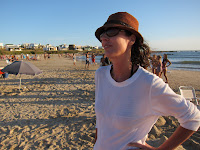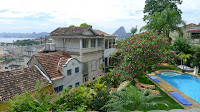This was a bit of gambit. Cabo Polonio is set deep within a nature reserve, where the only access is a sandy track 30mins by military grade 4x4. There's no running water or electricity, and rudimentary infrastructure. One might have expected "Princess & the Pea" reactions from Iris and Jasmine. But they took it in their stride. And though a 12hr journey by taxi/ ferry/ car/ jeep from Buenos Aires, it was absolutely magical. Here you really encounter the wide open spaces of the countryside and coast.
Arriving after nightfall, it was incredible how brightly candlelit Cabo Polonio shone on the horizon, reflecting the brilliant stars above. The night-time ride in the "Safari Express" was like a fairground ride crossed with a bucking bronco.
 |
| Home in Cabo |
We were buffeted by strong Atlantic winds for the nights we were there, though the whistling in the simple windowpanes was drowned out by the night-long musical revelry. Dred-locked travellers, backpacking students and others, here everyone is singing, seemingly all the time. Bonfires ablaze, hearts ablaze with song, "facciamo l'amore" and other Southern ballads sung with more fervour than I'd ever heard in Spain, Italy or Portugal. And through the the beaches are ringing with reggae and local tunes everyone (but us) seem to know the words to.
Don't for a minute think it's just the jugglers and wandering minstrels, looking so medieval with their dreds and dogs. Here they play violins and trumpets on the beach as well as guitars. But alongside them you have the local equivalent of the frat boys and sorority girls singing their favourite tunes.
The beaches and dunes extend to the horizon on either side of Cabo. Plenty of room for everyone, and everybody gets along - families with little kids, the sunkist boys taking lessons from their surf instructor, a ringer for Iggy Pop, the local philosopher dressed head to toe in white to match his windswept hair, the ageing sombrero man with his "Polonio Resistencia" t-shirt, the middle-aged guys playing the local version of petanque with utter seriousness.
Here it seems the beatniks and punks are the entrepreneurs, wandering the beach improvising mojitos, Fernet Cola or banuelos de algas, seaweed fritters (delicious). But walk far enough in either direction and it's just you, the dunes, the occasional stray spider crab or sandpiper. It wasn't the season for sea-lions, though Jasmine and Flo were lucky enough to swim with the dolphin of the bay.
Although I've never been to that desert gathering, I imagine Burning Man to be a bit like this, an improvised community conjured up in the wilderness. The utility vehicles - not just the "bus" but the water truck, the trash trucks, the food delivery - are like something out of Road Warrior. Flo awoke on the first morning to a beutiful sunrise and a horse at the door. Horses, dogs and chickens, but somehow especially the horses, mingle among the 2000 or so inhabitants. In the winter apparently the population dwindles to 72, mostly fishermen.
It's still peak season here, but feels like we're the only Europeans or Anglo Saxons, practically the only foreigners around, not counting the portenos. This is what it feels like to be far from home, and it feels good.






















































